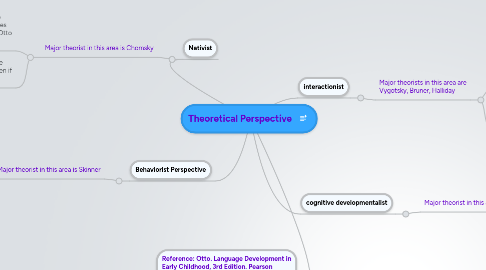
1. Behaviorist Perspective
1.1. Major theorist in this area is Skinner
1.1.1. “A child is considered to be a “blank slate”, and learning occurs due to associations established between stimuli, responses, and events that occur after the response behavior. Language is learned as a result of these associations” (Otto 30).
1.1.2. Meaning that children learn through interaction with their families and caregivers.
2. Nativist
2.1. Major theorist in this area is Chomsky
2.1.1. "Chomsky contends that all people inherently have the capacity to acquire language due to cognitive structures that process language differently from other stimuli" (Otto 28).
2.1.2. States that children are actually born with the ability to communicate and it will develop even if they are not nurtured.
3. Reference: Otto. Language Development in Early Childhood, 3rd Edition. Pearson Learning Solutions. <vbk:0558415040#outline(6.1.1)>.
4. cognitive developmentalist
4.1. Major theorist in this area is Piaget
4.1.1. "The emphasis of this perspective is that language is acquired as maturation occurs and cognitive competencies develop" (Otto 30)
4.1.2. Piaget proposed that cognitive growth leads to language acquisition.
5. interactionist
5.1. Major theorists in this area are Vygotsky, Bruner, Halliday
5.1.1. This perspective explains that the acquisition of language in young children happens because they keep trying to communicate with the people around them and they gain their language through those attempts.
5.1.2. Meaning that children have to acquire language, because they need to be able to talk in their social circles so that they can be a functioning part of society.
